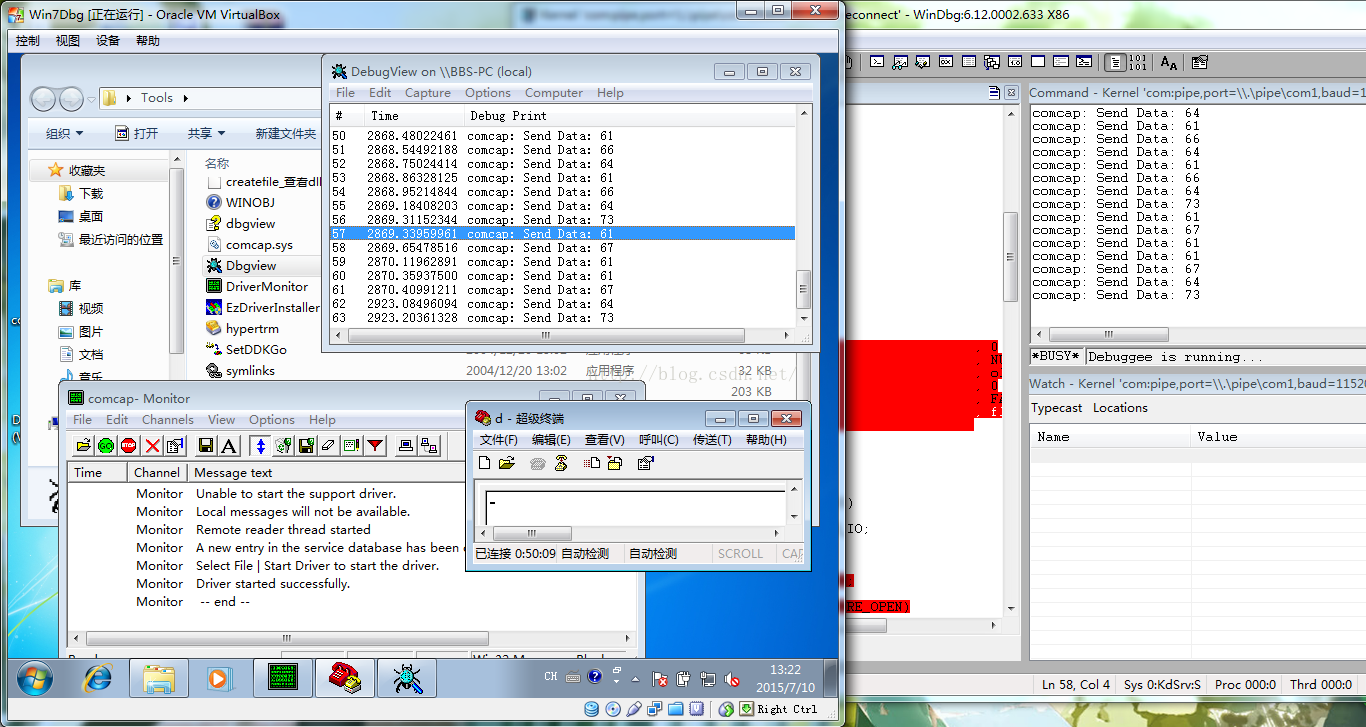1
2
3
4
5
6
7
8
9
10
11
12
13
14
15
16
17
18
19
20
21
22
23
24
25
26
27
28
29
30
31
32
33
34
35
36
37
38
39
40
41
42
43
44
45
46
47
48
49
50
51
52
53
54
55
56
57
58
59
60
61
62
63
64
65
66
67
68
69
70
71
72
73
74
75
76
77
78
79
80
81
82
83
84
85
86
87
88
89
90
91
92
93
94
95
96
97
98
99
100
101
102
103
104
105
106
107
108
109
110
111
112
113
114
115
116
117
118
119
120
121
122
123
124
125
126
127
128
129
130
131
132
133
134
135
136
137
138
139
140
141
142
143
144
145
146
147
148
149
150
151
152
153
154
155
156
157
158
159
160
161
162
163
164
165
166
167
168
169
170
171
172
173
174
175
176
177
178
179
180
181
182
183
184
185
186
187
188
189
190
191
192
193
194
195
196
197
198
199
200
201
202
203
204
205
206
207
208
209
210
211
212
213
214
215
216
217
218
219
220
221
222
223
224
225
226
227
228
229
230
231
|
#include
#define NTSTRSAFE_LIB
#include
#define CPP_MAX_COM_ID 32
#define DELAY_ONE_MICROSECOND (-10)
#define DELAY_ONE_MILLISECOND (DELAY_ONE_MICROSECOND*1000)
#define DELAY_ONE_SECOND (DELAY_ONE_MILLISECOND*1000)
static PDEVICE_OBJECT s_fltobj[CPP_MAX_COM_ID] = {0};
static PDEVICE_OBJECT s_nextobj[CPP_MAX_COM_ID] = {0};
NTSTATUS ccpAttachDevice(
PDRIVER_OBJECT driver
, PDEVICE_OBJECT oldobj
, PDEVICE_OBJECT *fltobj
, PDEVICE_OBJECT *next)
{
NTSTATUS status;
PDEVICE_OBJECT topdev = NULL;
status = IoCreateDevice (driver, 0, NULL, oldobj->DeviceType, 0, FALSE, fltobj);
if (status != STATUS_SUCCESS)
{
return status;
}
if (oldobj -> Flags & DO_BUFFERED_IO)
{
(*fltobj)->Flags |= DO_BUFFERED_IO;
}
if (oldobj->Flags & DO_DIRECT_IO)
{
(*fltobj)->Flags |= DO_DIRECT_IO;
}
if (oldobj->Flags & FILE_DEVICE_SECURE_OPEN)
{
(*fltobj)->Characteristics |= FILE_DEVICE_SECURE_OPEN;
}
(*fltobj)->Flags |= DO_POWER_PAGABLE;
topdev = IoAttachDeviceToDeviceStack (*fltobj, oldobj);
if (NULL == topdev)
{
IoDeleteDevice (*fltobj);
*fltobj = NULL;
status = STATUS_UNSUCCESSFUL;
return status;
}
*next = topdev;
(*fltobj)->Flags = (*fltobj)->Flags & ~DO_DEVICE_INITIALIZING;
return STATUS_SUCCESS;
}
PDEVICE_OBJECT cppOpenCom(ULONG id, NTSTATUS *status)
{
UNICODE_STRING name_str;
static WCHAR name[32] = {0};
PFILE_OBJECT fileobj = NULL;
PDEVICE_OBJECT devobj = NULL;
memset (name, 0, sizeof(WCHAR)*32);
RtlStringCchPrintfW(name, 32, L"\\Device\\Serial%d", id);
RtlInitUnicodeString (&name_str, name);
*status = IoGetDeviceObjectPointer(&name_str, FILE_ALL_ACCESS, &fileobj, &devobj);
if (*status == STATUS_SUCCESS)
{
ObDereferenceObject(fileobj);
}
return devobj;
}
void cppAttachAllCom(PDRIVER_OBJECT driver)
{
ULONG i;
PDEVICE_OBJECT com_ob;
NTSTATUS status;
for (i = 0; i < CPP_MAX_COM_ID; ++i)
{
com_ob = cppOpenCom (i, &status);
if (NULL == com_ob)
{
continue;
}
ccpAttachDevice(driver, com_ob, &s_fltobj[i], &s_nextobj[i]);
}
}
NTSTATUS ccpDispatch(PDEVICE_OBJECT device, PIRP irp)
{
PIO_STACK_LOCATION irpsp = IoGetCurrentIrpStackLocation (irp);
NTSTATUS status;
ULONG i, j;
for (i = 0; i < CPP_MAX_COM_ID; ++i)
{
if (device == s_fltobj[i])
{
if (irpsp->MajorFunction == IRP_MJ_POWER)
{
PoStartNextPowerIrp (irp);
IoSkipCurrentIrpStackLocation (irp);
return PoCallDriver (s_nextobj[i], irp);
}
if (irpsp->MajorFunction == IRP_MJ_WRITE)
{
ULONG len = (irpsp->Parameters.Write.Length);
PUCHAR buf = NULL;
if (irp->MdlAddress != NULL)
{
buf = (PUCHAR)MmGetSystemAddressForMdlSafe(
irp->MdlAddress, NormalPagePriority);
}
else
{
buf = (PUCHAR)irp->UserBuffer;
}
if (NULL == buf)
{
buf = (PUCHAR)irp->AssociatedIrp.SystemBuffer;
}
for (j = 0; j < len; ++j)
{
DbgPrint("comcap: Send Data: %2x\r\n", buf[j]);
}
}
IoSkipCurrentIrpStackLocation (irp);
return IoCallDriver (s_nextobj[i], irp);
}
}
irp->IoStatus.Information = 0;
irp->IoStatus.Status = STATUS_INVALID_PARAMETER;
IoCompleteRequest(irp, IO_NO_INCREMENT);
return STATUS_SUCCESS;
}
void ccpUnload(PDRIVER_OBJECT drv)
{
ULONG i;
LARGE_INTEGER interval;
for (i = 0; i < CPP_MAX_COM_ID; ++i)
{
if (NULL != s_nextobj[i])
{
IoDetachDevice (s_nextobj[i]);
}
}
interval.QuadPart = 5*1000*DELAY_ONE_MILLISECOND;
KeDelayExecutionThread (KernelMode, FALSE, &interval);
for (i = 0; i < CPP_MAX_COM_ID; ++i)
{
if (NULL != s_fltobj[i])
{
IoDeleteDevice (s_fltobj[i]);
}
}
}
NTSTATUS DriverEntry(PDRIVER_OBJECT driver, PUNICODE_STRING reg_path)
{
size_t i;
#if DBG
_asm int 3;
#endif
for (i = 0; i < IRP_MJ_MAXIMUM_FUNCTION; ++i)
{
driver->MajorFunction[i] = ccpDispatch;
}
driver->DriverUnload = ccpUnload ;
cppAttachAllCom (driver);
return STATUS_SUCCESS;
}
|

